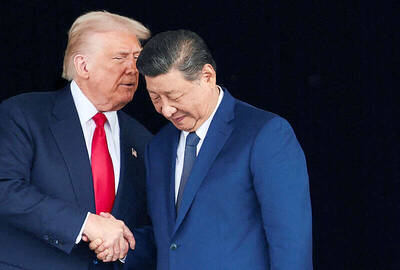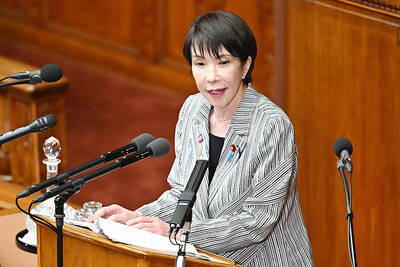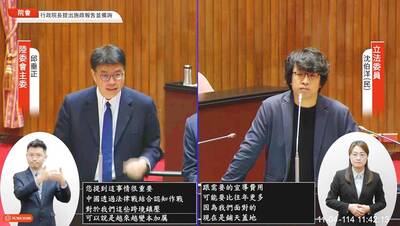Taiwanese artists have raised concerns about a Beijing art gallery’s plans to open a branch in Taipei in April, even before the legislature has begun its review of the cross-strait service trade agreement signed last year.
Beijing-based Aura Gallery is setting up a branch, with registered capital of about NT$150 million (US$5.06 million), on Taipei’s Dunhua S Road.
The gallery decided to set up a branch in Taipei because of the strong purchasing power of the city’s residents and their appreciation of art, but it had no plans to shift its focus from Chinese contemporary art and photography or to represent Taiwanese artists, Taipei branch art director Huang Ya-chi (黃亞紀) said.
The average annual sales volume of Taipei’s art market is about NT$5 billion, according to Taiwan Art Gallery Association statistics.
The Beijing gallery’s scheduled entry has alarmed Taiwanese artists, who say they already have a hard time competing against their Chinese counterparts.
Taipei-based InSian Gallery director Ou Shih-hao (歐士豪) said China has given little credit to Taiwanese art and artists, as evidenced by the failure of the globally renowned Juming Museum to make the list of China’s top 50 art museums.
The museum in New Taipei City’s Jinshan District (金山) showcases the work of Ju Ming (朱銘), the nation’s best-known sculptor.
“Over the past two years, a number of Chinese investors have expressed an interest in renting warehouses in Taipei’s Huashan 1914 Creative Park and Songshan Cultural and Creative Park for exhibitions, but I never thought they would one day enter [Taiwan’s market],” Ou said.
Ou said he was deeply worried about what would happen to Taiwanese artists if the legislature ratifies the service trade accord. They could be left vulnerable to Chinese-funded galleries’ ill-intentioned efforts to stifle their vitality and creativity by turning them into “mama’s boys,” he said.
Taiwanese artist Huang Chia-liang (黃家良) said although he has staged two solo exhibitions and taken part in a number of joint ones, he still has a difficult time finding a gallery willing to represent him because of the apparent shift in the local art market in recent years to Chinese painters.
“It takes at least five years for young Taiwanese artists to be noticed... I am afraid the passage of the service trade agreement may bode ill for their dreams of becoming professional artists,” Huang said.
Chow Mei-li (周美里), the Taiwan Solidarity Union’s policy and publicity director, said that under the WTO framework, Taiwan’s retail sector has only been slightly open to China — as required by an executive order, which is still subject to repeal.
“However, if the service trade accord is ratified, there will be something of a ‘controlling spell’ on Taiwan. There is a good chance that after Chinese-funded galleries gain a foothold, they might join hands with other Chinese-funded companies to provide end-to-end tourism service … which could pose a serious challenge to local galleries,” Chow said.
National Taiwan University economics professor Kenneth Lin (林向愷) said the ratification of the service trade pact would allow deep-pocketed Chinese investors to monopolize Taiwan’s art market and help Beijing enforce its “united front” tactics in the cultural sector.
“Since every piece of artwork is irreplaceable, Chinese investors could easily drive local art galleries out of business by buying up their best collections and prohibiting Chinese artists from approaching them to show their work,” Lin said.
The service trade agreement, which was signed in June last year, has been stalled in the legislature because of objections from opposition lawmakers, who are concerned that it will harm the nation’s interests.
President Ma Ying-jeou (馬英九) has repeatedly urged lawmakers to begin reviewing the agreement as soon as the last hearing on it is held next month.
He said that any delay in ratifying the pact will create doubt in the international community about Taiwan’s willingness to abide by or take part in international trade accords or blocs.
Additional reporting by CNA

‘SECRETS’: While saying China would not attack during his presidency, Donald Trump declined to say how Washington would respond if Beijing were to take military action US President Donald Trump said that China would not take military action against Taiwan while he is president, as the Chinese leaders “know the consequences.” Trump made the statement during an interview on CBS’ 60 Minutes program that aired on Sunday, a few days after his meeting with Chinese President Xi Jinping (習近平) in South Korea. “He [Xi] has openly said, and his people have openly said at meetings, ‘we would never do anything while President Trump is president,’ because they know the consequences,” Trump said in the interview. However, he repeatedly declined to say exactly how Washington would respond in

Japanese Prime Minister Sanae Takaichi said yesterday that China using armed force against Taiwan could constitute a "survival-threatening situation" for Japan, allowing the country to mobilize the Japanese armed forces under its security laws. Takaichi made the remarks during a parliamentary session yesterday while responding to a question about whether a "Taiwan contingency" involving a Chinese naval blockade would qualify as a "survival-threatening situation" for Japan, according to a report by Japan’s Asahi Shimbun. "If warships are used and other armed actions are involved, I believe this could constitute a survival- threatening

WARFARE: All sectors of society should recognize, unite, and collectively resist and condemn Beijing’s cross-border suppression, MAC Minister Chiu Chui-cheng said The number of Taiwanese detained because of legal affairs by Chinese authorities has tripled this year, as Beijing intensified its intimidation and division of Taiwanese by combining lawfare and cognitive warfare, the Mainland Affairs Council (MAC) said yesterday. MAC Minister Chiu Chui-cheng (邱垂正) made the statement in response to questions by Democratic Progressive Party (DPP) Legislator Puma Shen (沈柏洋) about the government’s response to counter Chinese public opinion warfare, lawfare and psychological warfare. Shen said he is also being investigated by China for promoting “Taiwanese independence.” He was referring to a report published on Tuesday last week by China’s state-run Xinhua news agency,

‘ADDITIONAL CONDITION’: Taiwan will work with like-minded countries to protect its right to participate in next year’s meeting, the foreign ministry said The US will “continue to press China for security arrangements and protocols that safeguard all participants when attending APEC meetings in China,” a US Department of State spokesperson said yesterday, after Beijing suggested that members must adhere to its “one China principle” to participate. “The United States insists on the full and equal participation of all APEC member economies — including Taiwan — consistent with APEC’s guidelines, rules and established practice, as affirmed by China in its offer to host in 2026,” the unnamed spokesperson said in response to media queries about China putting a “one China” principle condition on Taiwan’s